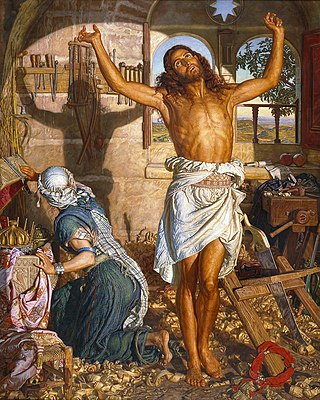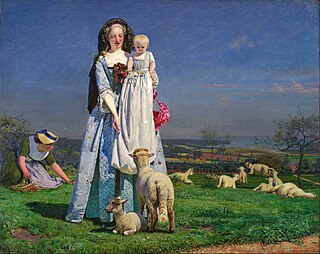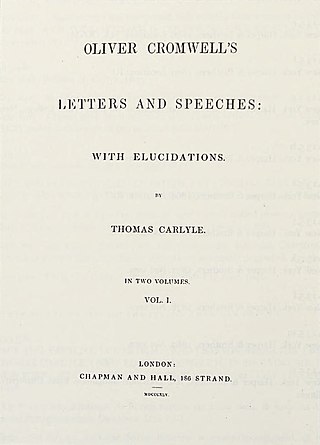Composition
The painting's central theme is that of enforced inertia. In it, Cromwell is portrayed as someone who has the capacity to become a major player on the national stage, but who is restricted to his own small world. It emphasises inertia through the portrayal of the distraction of Cromwell's horse by wayside fodder, which is also being eaten by a lamb from the farm: a reference to the concept of the Christian flock. The wandering piglets following a sow under Cromwell's horse refer to the story of the Gadarene swine. Cromwell carries an oak sapling in lieu of a whip, and a copy of the Bible.
The farm is a metaphor for the state, a place in which orderly labour is threatened continually by forces of disorder and in which the most everyday details are potentially filled with moral and eschatological significance. [2] While the workers on the left of the composition are getting on with their labours, clearing away weeds, the servant at the right is demanding a response from Cromwell, her shout repeated by the screeching duck she carries. The pigs under the horse and the lamb all create a potential for disruption and instability. Behind the workers clearing weeds, a young farm worker barely controls the large herd of cattle streaming through the gate into Crowmell's farm, separating the latter from his wife and child, visible at the door of the house at the right. A spot of blood can be seen on Cromwell's collar, a reference to a famous description of him by Sir Philip Warwick, and emblematic of a bloodstained future. [3]

Ford Madox Brown was a British painter of moral and historical subjects, notable for his distinctively graphic and often Hogarthian version of the Pre-Raphaelite style. Arguably, his most notable painting was Work (1852–1865). Brown spent the latter years of his life painting the twelve works known as The Manchester Murals, depicting Mancunian history, for Manchester Town Hall.

Oliver Cromwell was an English statesman, politician and soldier, widely regarded as one of the most important figures in the history of the British Isles. He came to prominence during the 1639 to 1653 Wars of the Three Kingdoms, initially as a senior commander in the Parliamentarian army and latterly as a politician. A leading advocate of the execution of Charles I in January 1649, which led to the establishment of The Protectorate, he ruled as Lord Protector from December 1653 until his death in September 1658. Cromwell remains a controversial figure due to his use of the army to acquire political power, and the brutality of his 1649 campaign in Ireland.

Ford Madox Ford was an English novelist, poet, critic and editor whose journals The English Review and The Transatlantic Review were important in the development of early 20th-century English and American literature.

The Pre-Raphaelite Brotherhood was a group of English painters, poets, and art critics, founded in 1848 by William Holman Hunt, John Everett Millais, Dante Gabriel Rossetti, William Michael Rossetti, James Collinson, Frederic George Stephens and Thomas Woolner who formed a seven-member "Brotherhood" modelled in part on the Nazarene movement. The Brotherhood was only ever a loose association and their principles were shared by other artists of the time, including Ford Madox Brown, Arthur Hughes and Marie Spartali Stillman. Later followers of the principles of the Brotherhood included Edward Burne-Jones, William Morris and John William Waterhouse.
Sir Philip Warwick, English writer and politician, born in Westminster, was the son of Thomas Warwick, or Warrick, a musician.

The Lady Lever Art Gallery is a museum founded and built by the industrialist and philanthropist William Lever, 1st Viscount Leverhulme and opened in 1922. The Lady Lever Art Gallery is set in the garden village of Port Sunlight, on the Wirral and one of the National Museums Liverpool.

The Germ, thoughts towards nature in art and literature (1850) was a periodical established by the Pre-Raphaelite Brotherhood to disseminate their ideas. The magazine was edited by William Michael Rossetti. The Germ was renamed Art and Poetry, being Thoughts towards Nature, conducted principally by Artists for its last two issues. It was not a success, only surviving for four issues between January and April 1850.

Frank Soskice, Baron Stow Hill, was a British lawyer and Labour Party politician.
Russet is a dark brown color with a reddish-orange tinge. As a tertiary color, russet is an equal mix of orange and purple pigments. The first recorded use of russet as a color name in English was in 1562.

Past and Present is a book by the Scottish essayist, historian and philosopher Thomas Carlyle. It was published in April 1843 in England and the following month in the United States. It combines medieval history with criticism of 19th-century British society. Carlyle wrote it in seven weeks as a respite from the harassing labor of writing Oliver Cromwell's Letters and Speeches. He was inspired by the recently published Chronicles of the Abbey of Saint Edmund's Bury, which had been written by Jocelin of Brakelond at the close of the 12th century. This account of a medieval monastery had taken Carlyle's fancy, and he drew upon it in order to contrast the monks' reverence for work and heroism with the sham leadership of his own day.

The Shadow of Death is a religious painting by the English painter William Holman Hunt, on which he worked from 1870 to 1873, during his second trip to the Holy Land. It depicts Jesus as a young man prior to his ministry, working as a carpenter. He is shown stretching his arms after sawing wood. The shadow of his outstretched arms falls on a wooden spar on which carpentry tools hang, creating a "shadow of death" prefiguring the crucifixion. His mother Mary is depicted from behind, gazing up at the shadow, having been looking into a box in which she has kept the gifts given by the Magi.

The Last of England is an 1855 oil-on-panel painting by Ford Madox Brown depicting two emigrants leaving England to start a new life in Australia with their baby. The painting has an oval format and is in the Birmingham Museum and Art Gallery.

Work (1852–1865) is a painting by Ford Madox Brown that is generally considered to be his most important achievement. It exists in two versions. The painting attempts to portray, both literally and analytically, the totality of the Victorian social system and the transition from a rural to an urban economy. Brown began the painting in 1852 and completed it in 1865, when he set up a special exhibition to show it along with several of his other works. He wrote a detailed catalogue explaining the significance of the picture.

Cromwell, Protector of the Vaudois (1877) is a painting by Ford Madox Brown which depicts Oliver Cromwell in conversation with John Milton dictating a letter to Andrew Marvell protesting at the Piedmontese Easter massacre (1655), an attack on the Vaudois (Waldenses), a persecuted Protestant sect in Piedmont, northern Italy. It was Brown's second Cromwell painting, following Cromwell on his Farm (1875).

The Manchester Murals are a series of twelve paintings by Ford Madox Brown in the Great Hall of Manchester Town Hall and are based on the history of Manchester. Following the success of Brown's painting Work he was commissioned to paint six murals for its Great Hall. Another six murals were to be completed by Frederic Shields who later withdrew, leaving Brown to complete all twelve works. The murals were begun in 1879, towards the end of Brown's career, but were not completed until 1893, the year he died. During this period he moved from London to Manchester with his family, first living in Crumpsall and then Victoria Park.

Take Your Son, Sir! (1851–56) is an unfinished painting by Ford Madox Brown which depicts a woman showing her newborn son to its father. She is offering her baby towards the viewer of the painting, who is implicitly equated with the father - seen in the mirror behind, opening his arms to receive the baby. The mirror also forms a halo behind the mother's head, and the pattern on the wallpaper suggests the starry heavens. Brown's principal influence was Jan van Eyck's painting the Arnolfini Marriage Portrait, recently acquired by the National Gallery. The mirror resembles the circular mirror in van Eyck's painting, which reflects an image of the artist looking at the couple in the image.

Oliver Cromwell was an English military and political leader and later Lord Protector of the Commonwealth of England, Scotland and Ireland.

Catherine Madox Brown Hueffer, also known as Cathy, the first child of Ford Madox Brown and Emma Hill, was an artist and model associated with the Pre-Raphaelites and married to the writer Francis Hueffer.

The Pretty Baa-Lambs is an oil-on-panel painting executed in 1851 by the English Pre-Raphaelite artist Ford Madox Brown and part of the collection of Birmingham Museums and Art Gallery.

Oliver Cromwell's Letters and Speeches: with Elucidations is a book by the Scottish essayist, historian and philosopher Thomas Carlyle. It "remains one of the most important works of British history published in the nineteenth and twentieth centuries."

















